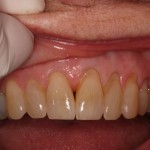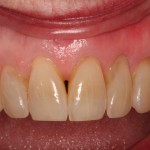How can gum recession be treated without using the patient’s own tissue
Historically, treatment of gum recession has always utilized the patient’s own tissue. This means that a second surgical site was needed in order to harvest donor tissue. These procedures included connective tissue graft and a free gingival graft. Today, there are more options for the patient and periodontist performing the procedure. Acellular dermal matrix allografts have been utilized as a replacement for the patient’s tissue. Allografts (such as Perioderm or Alloderm) are donated medically-processed human skin tissue. They provide a good alternative for several reasons. The largest benefit is that do not require a second surgical site, which increases post op pain and complications.
Example of how Alloderm can be used to treat recession
This patient was referred from her general dentist soft tissue grafting before esthetic treatment with veneers. She presented with a asymmetrical gingival contour, and horizontal bone loss. The amount of interproximal bone loss is a determinant to how much soft tissue coverage can be expected for recession. A Alloderm graft was utilized in order to correct this asymmetry and correct as much recession as possible. This treatment option did not require a second surgical site and the patient had minimal to no post operative pain. The asymmetry was corrected with minimal recession coverage. The patient was pleased with the outcome and understood that full recession coverage was impossible due to the amount of bone loss.
I treat many of my patients for gum recession with allografts.





 by
by 


